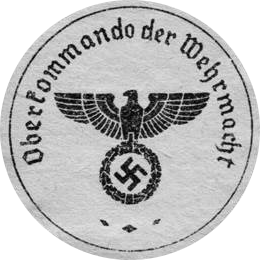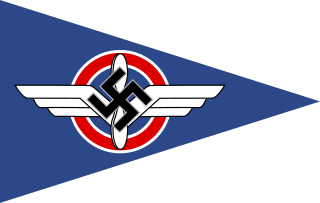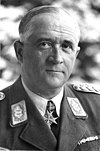
The Luftwaffe was the aerial-warfare branch of the Wehrmacht before and during World War II. Germany's military air arms during World War I, the Luftstreitkräfte of the Imperial Army and the Marine-Fliegerabteilung of the Imperial Navy, had been disbanded in May 1920 in accordance with the terms of the 1919 Treaty of Versailles, which banned Germany from having any air force.

The Oberkommando der Wehrmacht was the supreme military command and control office of Nazi Germany during World War II. Created in 1938, the OKW replaced the Reich Ministry of War and had oversight over the individual high commands of the country's armed forces: the army, navy, and air force. With the start of World War II, tactical control of the Waffen-SS was also exercised by it.

Adolf Josef Ferdinand Galland was a German Luftwaffe general and flying ace who served throughout the Second World War in Europe. He flew 705 combat missions and fought on the Western Front and in the Defence of the Reich. On four occasions, he survived being shot down, and he was credited with 104 aerial victories, all of them against the Western Allies.

Erhard Milch was a German Generalfeldmarschall who oversaw the development of the German air force (Luftwaffe) as part of the re-armament of Nazi Germany (1933-1945) following World War I (1914-1918). He served as State Secretary in the Reich Ministry of Aviation from May 1933 until June 1944 and as Inspector General of the air force from February 1939 to January 1945. During most of World War II he was in charge of German aircraft production and supply. In the Milch Trial of 1947, a U.S. military court convicted Milch of war crimes and of crimes against humanity, sentencing him to life imprisonment. However, in 1951 John J. McCloy, the U. S. High Commissioner for Germany, commuted Milch's sentence to 15 years. Paroled in 1954, Milch died in 1972.
Operation Adler was the code name designated by the Luftwaffe for their air offensive against Great Britain in the summer of 1940. The defensive side of this operation was known as the Battle of Britain. This offensive was part of an ambitious campaign, namely the amphibious invasion of England. The Luftwaffe bore the responsibility of neutralizing the Royal Air Force (RAF) and its capability to thwart the planned invasion. Operational planners were tasked with developing a plan to systematically destroy Great Britain's ability to wage war. This strategic air offensive was only one part of the overall campaign for the eventual invasion of England. The first step in this operation would be attaining air superiority for the invading force. Hermann Göring, the Luftwaffe Commander, violated all seven 'principles of war' as stated in U.S. Army Manual FM 100-5, but still came very close to defeating the RAF. The Luftwaffe's targeting of London was seen by the British as a fatal mistake. Adlertag was the Goring designated code name for the first day of German offensive air operations aimed at destroying the RAF.

Hugo Wilhelm Sperrle was a German military aviator in World War I and a Generalfeldmarschall in the Luftwaffe during World War II.

Between 1933 and 1945, the organization of the Luftwaffe underwent several changes. Originally, the German military high command, for their air warfare forces, decided to use an organizational structure similar to the army and navy, treating the aviation branch as a strategic weapon of war. Later on, during the period of rapid rearmament, the Luftwaffe was organized more in a geographical fashion.

The Federal Ministry of Defence, abbreviated BMVg, is a top-level federal agency, headed by the Federal Minister of Defence as a member of the Cabinet of Germany. The ministry is headquartered at the Hardthöhe district in Bonn and has a second office in the Bendlerblock building in Berlin, which is occasionally used as a metonym to denote the entire Ministry.

The Ural bomber was the initial aircraft design program/competition to develop a long-range bomber for the Luftwaffe, created and led by General Walther Wever in the early 1930s. Wever died in an air crash on June 3, 1936, and his successor Albert Kesselring continued the project until he left office.

The Ministry of Aviation was a government department during the period of Nazi Germany (1933–45). It is also the original name of the Detlev-Rohwedder-Haus building on the Wilhelmstrasse in central Berlin, Germany, which today houses the German Finance Ministry.

Hans Jeschonnek was a German military aviator in the Luftstreitkräfte during World War I, a general staff officer in the Reichswehr in the inter–war period and Generaloberst (Colonel-General) and a Chief of the General Staff in the Luftwaffe, the aerial warfare branch of the Wehrmacht during World War II.

Dietrich Peltz was a German World War II Luftwaffe bomber pilot and youngest general of the Wehrmacht. As a pilot he flew approximately 320 combat missions, including roughly 130 as a bomber pilot on the Eastern Front, 90 as a bomber pilot on the Western Front, and 102 as a dive bomber pilot during the invasion of Poland and Battle of France.

The Defence of the Reich is the name given to the strategic defensive aerial campaign fought by the Luftwaffe of Nazi Germany over German-occupied Europe and Germany during World War II against the Allied strategic bombing campaign. Its aim was to prevent the destruction of German civilians, military and civil industries by the Western Allies. The day and night air battles over Germany during the war involved thousands of aircraft, units and aerial engagements to counter the Allies bombing campaigns. The campaign was one of the longest in the history of aerial warfare and with the Battle of the Atlantic and the Allied naval blockade of Germany was the longest of the war. The Luftwaffe fighter force defended the airspace of German-occupied Europe against attack, first by RAF Bomber Command and then against the RAF and United States Army Air Forces (USAAF) in the Combined Bomber Offensive.

Martin Harlinghausen was a German military aviator and general. Harlinghausen specialised in maritime interdiction and anti-warship operations. During World War II Harlinghausen was the leading exponent of anti-ship warfare with the destruction of 22 ships credited to him.

Fliegerführer Atlantik was a World War II Luftwaffe naval air command for anti-maritime transport, anti-submarine, anti-surface fleet, close air support for the Kriegsmarine for operations in the Atlantic Ocean, maritime interdiction and maritime reconnaissance. The air command fought exclusively in the Battle of the Atlantic.

Joseph "Beppo" Schmid was a German general who served in the Luftwaffe during World War II. Schmid commanded the Luftwaffe's Military Intelligence Branch during the Battle of Britain.

Hans-Georg von Seidel was a German military leader who served in the German Army during World War I and in the Luftwaffe during World War II. Seidel was promoted to the rank of General der Flieger.

The German Air Sports Association was an organisation set up by the Nazi Party in March 1933 to establish a uniform basis for the training of military pilots. Its chairman was Hermann Göring and its vice-chairman Ernst Röhm.
Helmuth Förster was a German general in the Luftwaffe during World War II. A decorated World War I aviator, he returned to military service in 1934 as an Oberstleutnant in the Luftwaffe. Promoted to Oberst in 1936, he was appointed to command the 4th Bomber Wing. During the invasion of Poland, Förster, by now a Generalmajor, commanded the Luftwaffen-Lehrdivision with significant success. He was then appointed as chief of staff of the 5th Air Fleet during the invasion of Norway. After serving on the German-French Peace Commission, he was appointed as military governor of the German-occupied territory of Serbia from April to June 1941, then commanded the 1st Air Corps during the invasion of the Soviet Union until October 1942. Whilst in command of the 1st Air Corps he was awarded the Knight's Cross of the Iron Cross. He spent the remainder of the war as chief of administration at the Reich Ministry of Aviation. He was pensioned as an Oberstleutnant in 1952.

Wehrmacht Propaganda Troops was a branch of service of the Wehrmacht and the Waffen-SS of Nazi Germany during World War II. Subordinated to the High Command of the Wehrmacht, its function was to produce and disseminate propaganda materials aimed at the German troops and the population.




























